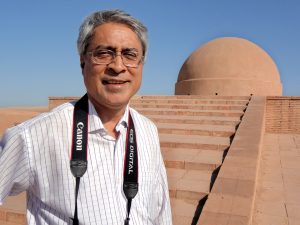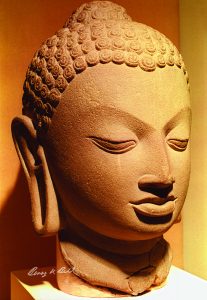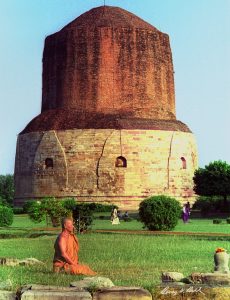Buddhism has always attracted me owing to its rational approach: Benoy K Behl
Photographer and Art Historian Benoy K Behl reveals his love for teachings of Buddhism, his exceptional journey and the many challenges he faced during them, as he gears up for the launch of his book which showcases Buddhist heritage spanning 17 countries.

C overing 59 countries and around 200 major cultural institutions and Buddhist temples for over 20 years, filmmaker, art historian and photographer Benoy K Behl is a name to reckon with. He has taken more than 50,000 photographs of Asian monuments’ and art heritage, and made 142 documentaries which are regularly screened at major cultural institutions worldwide. His photographic exhibitions have travelled to 59 countries around the world and have been inaugurated by ministers of the governments of various countries, ambassadors, archbishops and other such luminaries.
Is there more to his personality that we don’t know about? “I am just a person who was fortunate to discover a world of compassion in ancient art and the culture which it was born out of. It has been the journey of my life to share this message of kindness, grace and compassion, coming from ancient times,” an elated Behl tells Delhi Post ahead of the Indira Gandhi National Centre for the Arts’ Kala Nidhi Division’s ‘Book Talk on ‘Buddhism: The Path of Compassion’, to be held on September 4.
“The book, titled ‘Buddhism: The Path of Compassion’ which contains 238 photographs of 130 Buddhist heritage sites documented by Behl over a period of more than two decades in 17 countries, has been brought out by the Publications Division, Government of India.”
 “This book is based upon my two photographic exhibitions on ‘The Path of Compassion: The Buddhist Heritage of India’ and on ‘The Buddhist Heritage of the World’. These exhibitions were warmly received and held by about 250 major cultural institutions in 40 countries around the world including at the Shwedagon Pagoda in Myanmar, the Dunhuang Caves in China, the Tooth Relic Temple in Sri Lanka, the Lumbini site in Nepal, the Ryukoku University in Kyoto and the Japanese Buddhist Temple in Brazil, among others,” he says.
“This book is based upon my two photographic exhibitions on ‘The Path of Compassion: The Buddhist Heritage of India’ and on ‘The Buddhist Heritage of the World’. These exhibitions were warmly received and held by about 250 major cultural institutions in 40 countries around the world including at the Shwedagon Pagoda in Myanmar, the Dunhuang Caves in China, the Tooth Relic Temple in Sri Lanka, the Lumbini site in Nepal, the Ryukoku University in Kyoto and the Japanese Buddhist Temple in Brazil, among others,” he says.
Ask him about what inspires him towards Gautama Siddhartha’s teachings and his message of universal love and compassion, he tells Delhi Post, “Buddhism has always attracted me owing to its philosophic and rational approach. It is also a part of India’s heritage which is universally admired and I am very happy to see that the Government is taking a deep interest in promoting this vast and beautiful heritage of ours. Most people do not know many significant details about India’s Buddhist art and culture. This book would go a long way in creating greater awareness of the history of the development of Buddhism in India.”
“The book presents photographs from across India, Sri Lanka, Myanmar, Afghanistan, Nepal, Uzbekistan, Tibet, China, Vietnam, Thailand, Cambodia, Lao PDR, Indonesia, Siberia, Kalmykia in European Russia, Bangladesh, Bhutan, Mongolia and Japan.”
For instance, some of the photographs are namely ‘Birth of the Buddha, Recently Discovered Sculptural Panel, Phanigiri, First Century CE, Telangana, India’, ‘Mahaparinirvana, Cave 26, Ajanta, 6th Century CE, Maharashtra, India’ and ‘Eleven-headed Avalokitesvara, Cave 41, Kanheri Caves, 6th Century CE, Maharashtra, India’.
“The caves of Kanheri span a thousand years from the first century BCE onwards and illustrate developments in Buddhist art and iconography over this long period. It is the earliest-surviving image of the Vajrayana deity, who was to later become extremely popular in the Himalayan and trans-Himalayan regions,” Behl, who holds the Limca Book Record for being the most travelled photographer and art historian, apprises Delhi Post.
“His first brush with Buddhist heritage happened when he began photographing the rock-cut caves of Western India, including the paintings of Ajanta which was acknowledged in India and the world and had put him in touch with leading scholars of Indian art history.”

“Based on the work, in 1996, the National Museum of India commissioned me to produce an exhibition of my photographs of ‘Buddhist Sites and Art Heritage in India’. The exhibition was to be held in November that year, as part of the ‘Festival of India’ in Thailand,” recalls the veteran.
Behl, who went on to traverse a lot of places with a Buddhist past including Tibet, Nepal, China, Uzbekistan and Afghanistan recollects how some of the journeys were also fraught with risks.
“Some remote monasteries in Ladakh had no motorable roads and often I had to walk uphill. In a few places, where the distance to walk was very long and arduous (consequently dangerous in conditions of low oxygen), I somehow managed to arrange a horse to take me up. I will never forget the marvellous journey of four days, to and fro, from the Phugtal Monastery in Zanskar, in Ladakh. I did not know how to ride a horse, but the gentle and intelligent Zanskari pony seemed to understand that and took me very carefully up and down the steep mountain sides,” he says adding, “The journey in Afghanistan was not easy and there were at least two occasions when our lives were at considerable risk”.
Behl remembers how driving into Uzbekistan, near Termez, “was the most interesting experience”. “The people manning the border checkpoint didn’t know English and we did not know their language. Moreover, they seemed to have never seen Indians before. Among the things which they examined very carefully (and even kept for detailed scrutiny) were the newspapers which had been used to wrap different objects in our bags. We were at the checkpoint for more than two hours. However, the rest of the journey across Uzbekistan was fascinating and we enjoyed meeting the most-friendly and lovely people,” says Behl.
